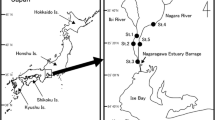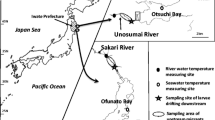Abstract
Microchemical analysis of the strontium (Sr) and calcium (Ca) ratios of otoliths was conducted to determine the life history and migration of anadromous Sakhalin taimen, Hucho perryi. In 2008 and 2009, 10 specimens were sampled from Lake Akkeshi in eastern Hokkaido, Japan. Our results indicated that some specimens migrated to brackish waters during their early life histories. Because the Sr:Ca ratios of the specimens in this study were all less than those of specimens from Sakhalin Island during a previous study, specimens from Lake Akkeshi may have migrated to brackish water, or may have remained in the ocean for only a short period.


Similar content being viewed by others
References
Arai T (2002) Migratory history of fishes: present status and perspectives of the analytical methods. Jpn J Ichthyol 49:1–23
Arai T (2010) Effect of salinity on strontium:calcium ratios in the otoliths of Sakhalin taimen, Hucho perryi. Fish Sci 76:451–455
Arai T, Miyazaki N (2002) Analysis of otolith microchemistry of chum salmon, Oncorhynchus keta, collected in Otsuchi Bay, northeastern Japan. Otsuchi Mar Sci 27:13–16
Arai T, Morita K (2005) Evidence of multiple migrations between freshwater and marine habitats of white-spotted charr, Salvelinus leucomaenis. J Fish Biol 66:888–895
Arai T, Tsukamoto K (1998) Application of otolith Sr:Ca ratios to estimate the migratory history of masu salmon, Oncorhynchus masou. Ichthyol Res 45:309–313
Arai T, Kotake A, Morita K (2004) Evidence of downstream migration of Sakhalin taimen, Hucho perryi, as revealed by Sr:Ca ratios of otolith. Ichthyol Res 51:377–380
Brenkman SJ, Corbett SC, Volk EC (2007) Use of otolith chemistry and radiotelemetry to determine age-specific migratory patterns of anadromous bull trout in the Hoh River, Washington. Trans Am Fish Soc 136:1–11
Edo K, Kawamula H, Higashi S (2000) The structure and dimensions of redds and egg pockets of the endangered salmonid, Sakhalin taimen. J Fish Biol 56:890–904
Edo K, Kawaguchi Y, Nunokawa M, Kawamula H, Higashi S (2005) Morphology, stomach contents and growth of the endangered salmonid, Sakhalin taimen Hucho perryi, captured in the Sea of Okhotsk, northern Japan: evidence of an anadromous form. Environ Biol Fish 74:1–7
Elsdon TS, Wells BK, Campana SE, Gillanders BM, Jones CM, Limburg KE, Secor DH, Thorrold SR, Walther BD (2008) Otolith chemistry to describe movements and life-history parameters of fishes—hypotheses, assumptions, limitations and inferences. Oceanogr Mar Biol Annu Rev 46:297–330
Esteve M, McLennan DA, Kawahara M (2009) Spawning behaviour of Sakhalin taimen, Parahucho perryi, from northern Hokkaido, Japan. Environ Biol Fish 85:265–273
Fukushima M (1994) Spawning migration and redd construction of Sakhalin taimen, Hucho perryi (Salmonidae) on northern Hokkaido Island, Japan. J Fish Biol 44:877–888
Fukushima M (2001) Salmonid habitat–geomorphology relationships in low-gradient streams. Ecology 82:1238–1246
Gritsenko OF, Malkin EM, Churikov AA (1974) Sakhalinskii taimen’ Hucho perryi (Brevoort) reki Bogatoi (vostochnoe poberezh’e Sakhalina). Izv Tikhookean Nauchno-Issled Inst Rybn Khoz Okeanogr 93:91–100 [Japanese translation by Oya Y (1976) Sakhalin taimen Hucho perryi in the Bogatoi River (eastern Sakhalin). Sakana to Ran 143:25–34]
Hokkaido Institute of Environmental Sciences (2005) Lakes and marshes in Hokkaido (revised edition). Hokkaido Institute of Environmental Sciences, Sapporo
Holčík J, Hensel K, Nieslanik J, Skácel L (1988) The Eurasian huchen, Hucho hucho. largest salmon of the world. Dr. Junk W Publishers, Dordrecht
Honda K, Noda Y, Tsuda Y, Yasuma H, Miyashita K (2009) Tracing seasonal migration of adult Sakhalin taimen, Hucho perryi, using acoustic telemetry. Jpn J Ecol 59:239–247
IUCN (2009) 2009 IUCN red list of threatened species. http://www.iucnredlist.org. Accessed 9 Sep 2009
Jonsson B, Jonsson N (1993) Partial migration: niche shift versus sexual maturation in fishes. Rev Fish Biol Fish 3:348–365
Kalish JM (1990) Use of otolith microchemistry to distinguish the progeny of sympatric anadromous and non-anadromous salmonids. Fish Bull 88:657–666
Kawamula H, Mabuchi M, Yonekawa T (1983) The Japanese huchen, Hucho perryi (Brevoort), collected in brackish water Lake Akkeshi, eastern Hokkaido, Japan. Sci Rep Hokkaido Fish Hatch 38:47–55
Kennedy BD, Folt CL, Blum JD, Chamberlain CP (1997) Natural isotope markers in salmon. Nature 387:766–767
Kimura S (1966) On the life history of the salmonid fish, Hucho perryi (Brevoort), found in Nemuro, Hokkaido. Jpn J Ichthyol 14:17–25
Komiyama E (2003) Freshwater fish in the Shiretoko. In: Shiretoko Museum (ed) Fish in the Shiretoko. The Hokkaido Shimbun Press, Sapporo, pp 10–141
Kraus RT, Secor DH (2004) Incorporation of strontium into otoliths of an estuarine fish. J Exp Mar Biol Ecol 302:85–106
Kuroki M, Ma T, Ishida R, Tsukamoto K (2006) Migratory history of wild and released ayu (Plecoglossus altivelis) in the Kurobe River, Japan. Coast Mar Sci 30:425–431
Limburg KE, Siegel DI (2006) The hydrogeochemistry of connected waterways, and the potential for tracing fish migrations. Northeast Geol Environ Sci 28:254–265
Maekawa K (1987) Life-history polymorphism and intraspecific differentiation of salmonids. In: Mizuno N, Goto A (eds) Japanese freshwater fishes. Tokai University Press, Tokyo, pp 112–123
Sagawa S, Yamashita S, Nakamura F (2002) Summer habitat use of adult Sakhalin taimen in a tributary of the Teshio River, Hokkaido, Japan: management implications for habitat conservation. Jpn J Ecol 52:167–176
Sagawa S, Yamashita S, Sato K, Nakamura F (2003) Fall habitat use and foraging mode of immature Sakhalin taimen in the river tributaries in northern Hokkaido, Japan. Jpn J Ecol 53:95–105
Suzuki K, Yoshitomi T, Kawaguchi Y, Edo K, Homma-Takeda S, Ishikawa T, Iso H, Imaseki H (2008) Application of micro-PIXE analysis for a migration history study of Hucho perryi focused on strontium distribution in fish scales. Int J PIXE 18:39–45
Tamate T, Yamamoto S (2004) Alternative life histories in salmonid fishes. In: Maekawa K (ed) Ecology and evolution of salmonids. Bunichi Sougou Shuppan, Tokyo, pp 43–63
Titus RG, Mosegaard H (1992) Fluctuating recruitment and variable life history of migratory brown trout. Salmo trutta L., in a small, unstable stream. J Fish Biol 41:239–255
Volk EC, Blakley A, Schroder SL, Kuehner SM (2000) Otolith microchemistry reflects migratory characteristics of Pacific salmonids: using otolith core chemistry to distinguish maternal associations with sea and freshwaters. Fish Res 46:251–266
Yamamoto S, Morita K, Goto A (1999) Geographic variations in life-history characteristics of white-spotted charr (Salvelinus leucomaenis). Can J Zool 77:871–878
Yamashiro S (1965) Age and growth of the ITO (Hucho perryi) in northeastern Hokkaido. Bull Jpn Soc Sci Fish 31:1–75
Acknowledgments
We thank T. Sato and other staff members at the Fisheries Cooperative Association of Akkeshi, and S. Takeyama, E. Yamaha, and M. Ichimura for their cooperation in capturing and supplying sample fish. We also thank M. Kaeriyama, H. Seo, and the students and staff of Arai’s Laboratory at the International Coastal Research Center, University of Tokyo, for their support and help with the analysis of otoliths, and K. Edo and K. Nomoto for their valuable advice. This study was supported by a grant-in-aid from the Foundation of River & Watershed Environment Management, Japan (No. 20-1215-1) and a Grant-in-Aid for Scientific Research into Lake Akkeshi and Bekanbeushi Wetlands (No. 23).
Author information
Authors and Affiliations
Corresponding author
Electronic supplementary material
Below is the link to the electronic supplementary material.
About this article
Cite this article
Honda, K., Arai, T., Takahashi, N. et al. Life history and migration of Sakhalin taimen, Hucho perryi, caught from Lake Akkeshi in eastern Hokkaido, Japan, as revealed by Sr:Ca ratios of otoliths. Ichthyol Res 57, 416–421 (2010). https://doi.org/10.1007/s10228-010-0174-2
Received:
Revised:
Accepted:
Published:
Issue Date:
DOI: https://doi.org/10.1007/s10228-010-0174-2




